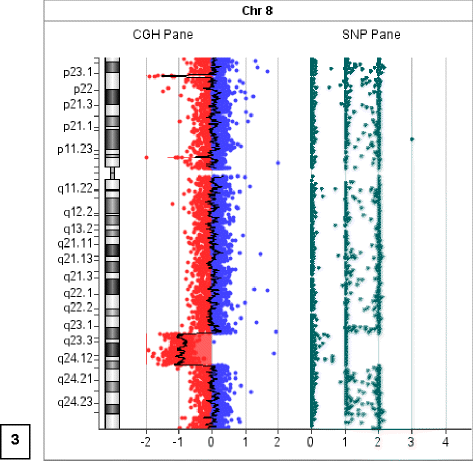An interstitial deletion at 8q23.1-q24.12 associated with Langer-Giedion syndrome/ Trichorhinophalangeal syndrome (TRPS) type II and Cornelia de Lange syndrome 4
- PMID: 26269715
- PMCID: PMC4534011
- DOI: 10.1186/s13039-015-0169-9
An interstitial deletion at 8q23.1-q24.12 associated with Langer-Giedion syndrome/ Trichorhinophalangeal syndrome (TRPS) type II and Cornelia de Lange syndrome 4
Erratum in
-
Erratum to: An interstitial deletion at 8q23.1-q24.12 associated with Langer-Giedion syndrome/ Trichorhinophalangeal syndrome (TRPS) type II and Cornelia de Lange syndrome 4.Mol Cytogenet. 2015 Sep 30;8:73. doi: 10.1186/s13039-015-0174-z. eCollection 2015. Mol Cytogenet. 2015. PMID: 26430469 Free PMC article.
Abstract
Background: There are three distinct subtypes of Trichorhinophalangeal syndrome (TRPS); TRPS type I, TRPS type II and TRPS type III. Features common to all three subtypes include sparse, slowly growing scalp hair, laterally sparse eyebrows, a bulbous tip of the nose (pear-shaped), and protruding ears. Langer-Giedion syndrome (LGS) or TRPS type II is a contiguous gene syndrome on 8q24.1, involving loss of functional copies of the TRPS1 and EXT1 genes. We report a male patient that was referred to the Department of Medical Genetics due to hypotonia and dysmorphic facial features.
Results: Cytogenetic and array- Comparative Genomic Hybridization (aCGH) analysis revealed that the patient was a carrier of an interstitial deletion at 8q23.1-q24.12 of 12,5 Mb. Parental karyotype indicated that the father carried an apparently balanced insertion: 46, ΧΥ, der(10)ins(10;8)(q22;q23q24).
Conclusions: This is the first report of an apparently balanced insertion including chromosomes 8 and 10 contributing to the etiology of LGS/ TRPS type II. Τimely diagnosis of parental balanced chromosomal rearrangements can reduce the risk of subsequent miscarriages as well as abnormal offspring.
Figures



References
-
- Sidler JA, Filges I, Boesch N, Ramelli GP, Röthlisberger B, Huber AR, et al. TRPS1 codon 952 constitutes a mutational hot spot in trichorhinophalangeal syndrome type I and could be associated with intellectual disability. Clin Dysmorphol. 2012;21:87–90. doi: 10.1097/MCD.0b013e32834e9248. - DOI - PubMed
-
- Piccione M, Niceta M, Antona V, Di Fiore A, Cariola F, Gentile M, et al. Identification of two new mutations in TRPS 1 gene leading to the tricho-rhino-phalangeal syndrome type I and III. Am J Med Genet A. 2009;149A:1837–41. - PubMed
-
- Shin HT, Chang MW. Trichorhinophalangeal syndrome, type II (Langer–Giedion syndrome). Dermatol Online J. 2001. - PubMed
-
- Sybert VP. Genetic skin disorders. Chapter hair shaft abnormalities, syndromic. Trichorhinophalangeal syndrome. 2. Oxford: Oxford University Press; 2010. pp. 225–228.
Publication types
LinkOut - more resources
Full Text Sources
Other Literature Sources
Miscellaneous

